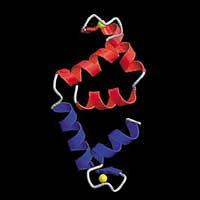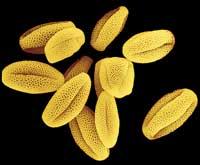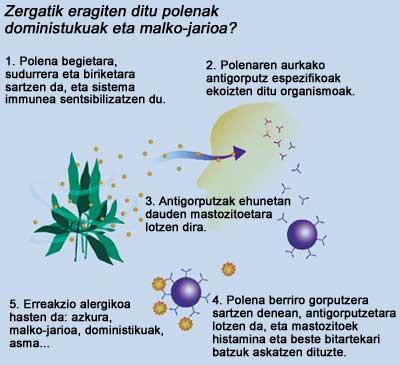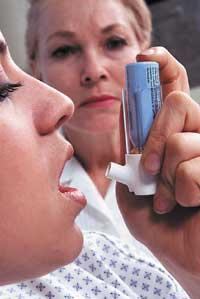Allergy: any place of risk

In the 1960s only 10% of the population was allergic, while recent studies point to one in five being considered allergic. Identifying the cause or cause of the allergic reaction and implementing an effective treatment plan are the most important things the allergic patient should do, as well as following medical advice.
What is an allergic reaction?
Immediate allergy or hypersensitivity is only an abnormal sensitivity to a substance that is generally well tolerated and not considered harmful. These substances that cause this abnormal body reaction are called allergens and are very varied. This immune system reaction starts in case of ingestion, inhalation, or contact with these allergens.

The immune system acts as a defense mechanism for the body against the countless ‘strange’ substances present in the air we breathe, the food we eat and the things we touch. Among these foreign substances, we use the word allergen to designate substances that cause an immunoallergic response.
However, we still do not know why some substances are allergenic and others do not, why some people respond allergic and others do not.
One of the essential features of the human immune system is knowledge and memory. What does that mean? Once the immune system cells take a substance as strange, they will remember this initial relationship forever. The reencounter with this specific substance will make the response of our body much faster and harder due to the chemical intermediaries created by the ‘memory’ cells activated as a result of this second exposure. These cells will amplify the response by starting other parts or parts of the immune system.

Another mechanism the immune system uses to defend against foreign external substances is the generation of millions of antibodies. Each antibody has the ability to know and associate a single external specific foreign substance. These antibodies or immunoglobulins are found in the blood and in almost all fluids in the body, and when they ‘know’ as strangers the material coming in from the outside, they help capture and immobilize them.
Human immunoglobulin or antibody (E Ig) is what is activated in most allergic reactions. One or more allergens (e.g. pollen, dust mites, fungi, etc.) It is said that the person who has developed special E Ig to know is sensitized against these allergens. E Ig molecules (specific against different allergens) reach through the blood to tissues, where they cover the entire surface of mast cells or barley cells. There may be 500,000 E Ig of different specificity on the surface of a single barley cell to know the different allergens and start an allergic reaction followed.

Barley cells or mast cells are very abundant in the nose, eyes, lung and digestive mucous membranes. And when an E Ig present in one of these cells meets an allergen molecule, if its ‘memory’ is activated with that specific allergen, the mast cell releases a lot of powerful chemical mediators, all of them of strong inflammatory influence. These intermediaries include histamines, leukotrienes and prostaglandins, as well as cytokines (protein molecules that regulate cell interactions).
Allergic reactions have been observed to cause inflammation or inflammation in tissues. But allergic reactions should be understood as a chain of events: When an E Ig knows its ‘specific’ allergen, an active barley cell releases intermediaries. These intermediaries then collect other inflammatory cells from the blood circulation for invasion of surrounding tissues. In them, with the help of other local cells, they release additional chemical mediators that complete the allergic reaction.
How to act in an allergy case?

Knowing which allergenic molecules are ‘known’ by the patient’s immune system is the safest way to diagnose allergy. For this, the most appropriate diagnoses are skin tests and blood specific E Ig presence screening (RAST tests).
Skin tests
Once the medical history is analyzed by the doctor, the allergen that may be the cause of these symptoms is suspected and tested on the patient's skin with extracts or extracts of these suspicious substances. These tests are usually done on the forearm, but can also be done on the shoulder or other parts of the body.
Once the body part is cleaned well, a drop of extract is placed and with a spear that drop is passed and on the forearm a scarification or a slight scratch is made. To assess this test, two controls are performed, one positive and one negative.


Positive control is done with a drop of histamine. As you will remember, histamine is one of the intermediaries that are released at the beginning of the allergic reaction and cause inflammation, causing skin redness, itching and inflammation. Negative control, on the other hand, is done with a drop of physiological serum, which allows us to know if the patient reacts excessively to any minor trauma (by predation with the size).
The interpretation of tests and controls carried out with extracts of allergens allegedly responsible for the allergy is done at 15 minutes. Once the drop of histamine reacts with the extract of the suspicious allergen, the suspect will be considered guilty if at this point a small inflammation appears that itches and appears a reddish or a kind of blister about 1.5 cm in diameter. The suspicious allergen, for its part, will be considered innocent if with it the point of ambition in the skin appears normally, without any redness or inflammation.
Laboratory tests
In addition to this test, a blood test will be performed in the laboratory to check the presence of antibodies in the blood and, if applicable, the amount available. It is about studying specific Ig, that is, detecting specific antigens responsible for allergy.
Once allergens are identified, the best treatment will be to reduce contact with these allergens as much as possible and use the appropriate drugs to reduce allergic symptoms and tissue inflammation. Allergy shots (known as immunotherapy) may also be used in certain cases.

Immunotherapy involves giving the allergic allergen to the patient at progressively higher doses. The allergen is injected subcutaneously in well-measured doses and at regular intervals. In this way, after several injections, it is possible to know the dose that each patient supports well, with which the body learns to ‘know’ and ‘accept’ the allergen that until then was harmful, and in the end does not cause any harm.
Is it possible to prevent allergy?
The appearance of an allergy is a change in lifestyle and daily habits if you want to avoid risk situations or reduce the frequency of crisis. It is not possible to take preventive measures against all types of allergies, but the ones listed below will help you.
If you drive the car
If a driver is distracted only by sneezing and the car moves at 90 km/h, this means touring about 25 meters without control. And considering that in an allergic crisis can reach 10 sneezes, this distance increases considerably.
A number of measures for the driver is:
- Do not drive the car with the box office open.
 Some allergies appear in childhood, but disappear in adolescence or adulthood.
Some allergies appear in childhood, but disappear in adolescence or adulthood. - Keep the inside of the car clean, even the ventilation ducts, as dust produces numerous allergic reactions.
- Wearing sunglasses as they prevent pollen from entering the eyes (at least in part) and reduce irritability of the eyes.
- During the trip, wash your nose and eyes with plenty of water to alleviate the effects of allergy.
- Do not cycle because it increases contact with air and increases allergic pollen symptoms.
- If you are taking antihistamines never drive, because this medicine gives you sleep. Never mix this medicine with alcohol.
- If a trip is essential, consult your doctor to stop or change the medication.
Welcome measures

It is not about being obsessed with allergy, of course, but if certain habits are acquired, our quality of life will be better.
- Ventilate the bedroom well and keep it low and dry, especially in areas with bed, armchairs and carpets.
- Use a damp cloth to remove dust from home.
- Vacuum, at least once a week, on the patient's mattress, under the bed, and on the carpets, carpets and armchairs throughout the house. Also on and under furniture and books.
- If possible, use special allergy vacuum cleaners that have a special dust holding capacity.
- Avoid the appearance of moisture in the home: facilitate air circulation by opening windows and doors.
- Make bed linen anti-allergic.
- Beware of plants inside the house: they have no dry leaves or molds.
- In case of having animals at home (especially cats or dogs) they will cut their hair often and comb well, avoiding that the hair is too dry.

The allergic person answers the following questions:
- What are the specific allergens my immune system knows?
- When and to what extent am I exposed?

As previously seen, the inflammatory allergic reaction and the chain of reaction after exposure of these allergens are responsible for the clinical symptoms of allergy.
- Allergic rhinitis is also called hay fever. It consists of allergens that come into contact with the nasal mucosa of a person sensitized to a certain allergen. The main symptoms are nasal congestion, itching, and mucous discharge; daily contact of nasal mucous membranes with allergens can turn inflammation and other symptoms into chronic.
- Allergic conjunctivitis Allergic ocular inflammatory reaction similar to rhinitis.
- Topical dermatitis or eczema is the result of the ‘fight’ between allergens and skin antibodies. This disease usually starts in infants, also appears in school and often improves (or almost disappears) in adolescence. But it can also be the precursor to adulthood asthma.
- Asthma is a chronic disease. Inflammation of the airways and excessive response cause coughing, chest distress, shortness of breath, beeps, etc., by obstruction or obstruction of airflow.
- It produces allergy to food, food additives and/or drugs or drugs. People sensitive to specific foods have allergic reactions after consumption. The most common allergens are shellfish, eggs, milk, wheat or peanuts, although they can be many more. They are frequent in childhood, but over time this hypersensitivity disappears in many cases.
- Anaphylactic shock This is the most serious of all allergic reactions. Inflammation spreads to all parts of the body (it is therefore a systemic response) and can even result in death, as inflammation of the airways can cause asphyxiation and blood pressure drops sharply. Anaphylaxis may appear after an injection of penicillin or after being bitten by an insect like a bee. In this case you should immediately apply epinephrine (adrenaline).





